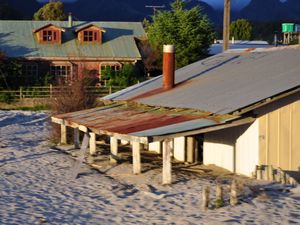Advertisement
Published: February 7th 2011

 A buried Chaiten
A buried Chaiten
where ash and debris remain 3 years later. Unpleasant to be stuck in the midst.The further south you head, the more you find infrequent public transport. This time we are stuck in Chaiten, a small volcanic town of only 8 streets buried in ash, no telefoniocas, no hot water and nothing to do. There are 2 restaurants which don't sell cafe con leche and 3 mini markets, where i go to buy my powdered milk to add to instant coffee (im desperate) and yet they still charge you the price of a cappuccino. Chaiten is meant to be a beautiful tourist town surrounded by a long coastline and national parks, yet i feel i'm in a prison unable to escape for another 2 nights as the only 1 bus that leaves and enters town doesn't depart Thursdays! We luck out again.
Due to the volcanic activity and uncertainty we don't want to climb in the rain this volcano, which destroyed the town on 2 May, 2008 when it woke up and began a month-long eruption. Its ashen cone rose 20km in the air and reached as far as Buenos Airesw in the neigbouring country! It caused severe damage to homes, bridges and roads and killed many animals and lovestock. Thankfully no one died and
people in the town were able to evacuate. Volcan Chaiten wasn't even ranked among chile's 120 volcanoes. Today, geoligists are monitoring its activity closely as they fear another dome could collapse.
the only thing that made this town bearable were the sae lions we spotted during our walk with our adopted dog for the day, prancer.
Futaleufu was well worth the wait. A long but picturesque drive to get there, some of the most beautiful scenery we have seen so far. Rolling farmland, backed by snow-capped mountains with hidden valleys and streams. Some of Chile’s rich and famous use this country for their holiday homes, and you can see why.
The town itself is small (a total of 8 or so streets) but nice with a man-made lake at one end near a small rodeo stadium. We had a pleasant picnic here but by far the food highlight was the fruit smoothies and tofu and carrot dips at Sur Andes café. We went back twice.
Futuleufu is world renowned in rafting circles so we decided to brave the ice-cold river. There are plenty of rafting outfits in town, but as luck would have it, the first one we
checked out was run by a Chilean Olympic kayaker. We would usually shop around for the best prices but we were pretty much sold on his credentials alone. The clincher was that his grandfather was Croatian……!
The rafting was fun once we got through the training and learned all the basics about high-side and low-side strokes. The water was a beautiful, transluscent, green colour, as it had come from the glacier. The scenery was amazing, winding through snow-capped peaks and abundant forests. One of our most memorable experiences so far, to have rafted one of the best rafting rivers in the world.
From Futaleufu we head south making our way towards Coyhaique to get to Patagonia. It’s hard to fathom the distances in Chile by merely looking at a map. We are already in the South and it has taken us more than one week to reach Patagonia and we still have a long way to go. We decide to cross the border at Chile Chico and head in to Argentina, a small rural town called Los Antiguos with nothing much to do. It’s the last border crossing into Argentina from Chile unless you want to hike on foot for
2 hours carrying your luggage through the Villa O’Higgins national park as there are no roads. The park is only accessible by boat.
It is quicker to go through Argentina to reach Peurto Natales, the hub for gore-tex clad travellers headed to the continent’s number one national park: Torres Del Paine.
Advertisement
Tot: 0.085s; Tpl: 0.01s; cc: 11; qc: 49; dbt: 0.0398s; 1; m:domysql w:travelblog (10.17.0.13); sld: 1;
; mem: 1.1mb

 A buried Chaiten
A buried Chaiten